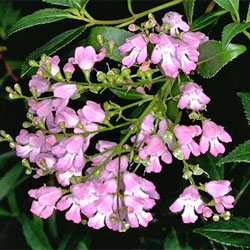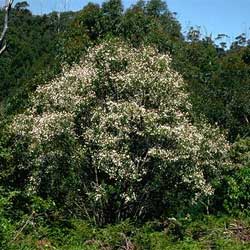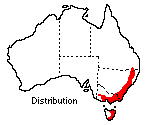Prostanthera lasianthos
 |
 |
Victorian Christmas Bush
Prostanthera lasianthos Labill.
Several Australian native species called Christmas Tree or Christmas Bush are actually very different, both in appearance and in botanical classification.
For example, in Western Australia it is Nuytsia floribunda, the brilliant orange tree related to Mistletoe and not found wild elsewhere. It is not yet widely cultivated in other areas. New South Wales Christmas Bush is Ceratopetalum gummiferum, a popular plant described elsewhere in these pages. Tasmanian Christmas Bush is one name for Bursaria spinosa, a shrub related to Pittosporum and often ignored in its wild state throughout temperate Australia. In a garden, it can be valuable for its scented cream flower sprays and seed vessels turning bright green, then bronze.
 This subject, Victorian Christmas Bush (Prostanthera lasianthos), is
the largest of the native Mint Bushes and has the widest distribution. It ranges
from southern Queensland to Tasmania from coastal to sub-alpine altitudes, and
grows from 2 m in exposed mountain sites to at least 10 m high.
This subject, Victorian Christmas Bush (Prostanthera lasianthos), is
the largest of the native Mint Bushes and has the widest distribution. It ranges
from southern Queensland to Tasmania from coastal to sub-alpine altitudes, and
grows from 2 m in exposed mountain sites to at least 10 m high.
It is best known as a tall, graceful forest shrub about 5 m high, and is popular also in the gardens of native plant lovers. It grows by creeks and in the moist shade of dense, wet sclerophyll forests, where it may have room to develop a good shape or scramble through a tangle of vegetation. Not far from Canberra towards the high mountains, it occurs in forest hollows, near tree ferns and luxuriant mosses, reaching 5 m. When not in flower it can be detected by its menthol fragrance when touched; though sometimes too strong, it is more pleasant than in some native Mint Bush scents.
Examples in the Australian National Botanic Gardens vary greatly owing to different origins and different planting positions. Plant form, leaf, flower and flowering time all vary, making an interesting study. Moist, shady conditions are not necessary for this species to grow, and it will recover from neglect as shown by older examples in the Gardens - 5 m shrubs 25 years old and growing in full sun. They were shaped by past droughts and storms into sprawling irregular shrubs with thin branches on which the upper bark is attractive and shiny. Storm loosening led to suckering branches which strengthened the shrubs and the bases became thick. Persistent upward stems replenished the frame after branches died back from drought or root-rot. In November they are weighed down with flowers nearly hiding the sparse foliage. They grew more leafy after the entire bed was mulched and watered regularly.
Younger specimens vary from compact ovals to tall lax shrubs, all tending to have long upright branches. Any shape can be had by trimming after flowering, though in these Gardens shaping is avoided. It is of interest in a botanic garden to note over the years how plants develop in conditions more harsh or more favourable than in their natural habitat.
Prostanthera lasianthos is unaffected by frost in Canberra and will grow in light or stiff soil in sun or shade, but constant wind should be avoided. It is excellent for hiding a fence, as a tall hedge or by a red brick wall. With a good mulch and some watering it would thrive in city gardens, giving flower when most purple Mint Bushes have finished.
Foliage is attractive in plants growing freely and can be bright-yellow green to darker green, hairless, sometimes shiny, and without blemish. Mountain forms and plants in full sun have slightly leathery foliage. Leaves are up to 15 cm long and from 13 mm to over 19 mm wide, larger than in other Prostanthera species. They vary in denseness, taper finely, and the margins are generally toothed, sometimes also waved or curved.
Masses of thin, soft flowers in wide-angled tapering sprays are the main attraction. The flowers are around 2 cm long and are funnel-shaped with spreading lower lobes. In the throat are tiny purple blotches and larger orange ones. In some the flowers are white but others, highly prized, appear pale pink or mauve from a distance. Close inspection shows suffused blotches of pale purple or violet, extending sometimes to the calyces and thin flower stems. These latter are slightly viscid and in some cases even more scented than the leaves.
A separate light perfume can sometimes be detected in the flowers, but generally it is masked by the minty scents. The flowering season is November rather than Christmas in Canberra though it lingers till January in some years, and no doubt Christmas flowers could be planned with the right form in a cool position. A magnifier allows one constant feature to be seen in the flowers - they are coated inside and out with fine hairs, a fact which sets this species apart from other Prostanthera spp. Short branches of flowers last well in water, and are graceful and easy to arrange.
Propagation is by seeds or cuttings. The only disease noticed has been die-back from the root-rot fungus referred to elsewhere, and as mentioned affected shrubs have fully recovered later.
Based on text by ANBG staff (1973)
Name meaning: Prostanthera lasianthosProstanthera - from Greek words meaning appendage and anther, referring to the structure of the stamens; lasianthos - hairy flowers |
![An Australian Government Initiative [logo]](/images/austgovt_brown_90px.gif)

